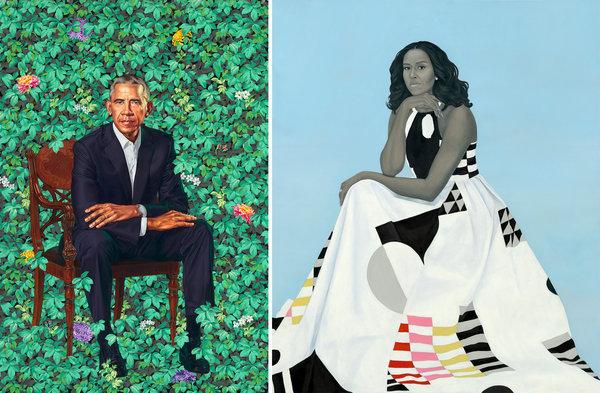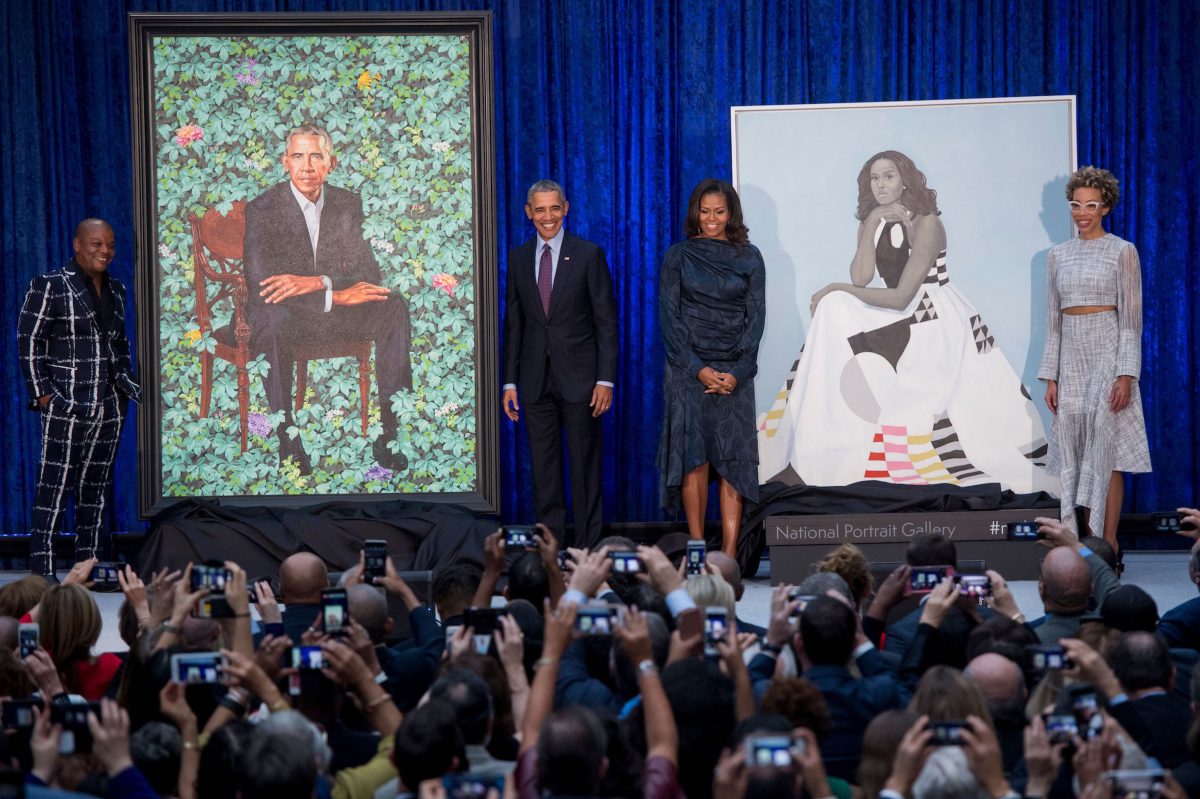In February, the Smithsonian Institution’s National Portrait Gallery unveiled the official portraits of Former President Barack Obama and Former First Lady Michelle Obama. Both portraits generated much attention due to their striking differences compared to typical Presidential portraits which are more subdued and formal, and the fact that not only are the Obama couple the first African-American presidential couple, but the artists behind the portraits are the first African-American artists chosen to paint the official portraits.

Credit: The New York Times
Kehinde Wiley, who painted Barack Obama’s portrait, is based in New York City and is famous for incorporating both heroic images of African-Americans and nature into his portraits. The 7-by-5 foot painting consists of Obama sitting in an elegant brown chair, leaning forward with his arms crossed across his lap. The chair is situated in what looks like a forest filled with bright green leaves and colorful flowers. The plants in the painting represent Obama’s life and heritage; the light blue lilies are typically found in Kenya, where Obama’s father is from while the purple chrysanthemum is the official flower of Chicago, a city that is very influential in Obama’s life and career.
Regarding Michelle’s portrait, Michelle chose Baltimore-based Amy Sherald to paint her portrait. Similar to the common theme Wiley uses in his portraits, Sherald incorporates all black models into her works, using grayscale to paint skin tones as a tool to challenge the concept of color-as-race. Sherald not only uses grayscale to make the skin tones of her models more ambiguous, but to create a “ghost” feeling to demonstrate that the models represent the past, present and future. The utilization of Sherald’s grayscale is also present in Michelle’s portrait where Michelle is sitting on what seems like a stool or chair, but her dress drapes over it.
In the 6-by-5 foot oil on linen portrait, Michelle is wearing a gown designed by Michelle Smith for Milly, in front of a sky blue background. In a recent interview with Vogue, Smith explained that the dress’s “clean, minimal geometric print” is without a reference to anything nostalgic and is instead forward-thinking, to represent Michelle. Moreover, Smith was part of a group of young designers who was selected to participate in the “Fashion Education Workshop” that Michelle hosted at the White House in 2014.
Looking at the themes present in both of the portraits, both Barack and Michelle Obama, with the help of Wiley’s and Sherald’s choices, stand out against the background and evoke deeper meanings, yet in a subtle way.
In Wiley’s portrait, Obama’s black, crisp suit creates very structured shapes due to the shape of his suit jacket and the way his arms are placed on his knees. These harsh edges contrast with the flowy, and almost soft texture of the background. Additionally, Obama is shown to be one with the leaves are flowers, enhancing one of his main assertions of his campaigns and presidency which is to never forget your origins. Although the modernism of Obama’s suit and body position communicates that he is more contemporary, the plants which represent his origins elicit a feeling of nostalgia, proving that his heritage will and should always be a part of him.
Sherald’s portrait of Michelle includes contrasts as well. The simplicity of the colors, due to the grayscale and the lack of a hectic background establishes modernity. Additionally, the lack of excessive intricacy in the design of the dress strengthens the timelessness of the portrait.
Similar to Obama’s portrait which makes reference to his heritage and culture, the quilt-like pattern of Michelle’s dress does the same. Quilting is often used to represent quintessential America. More specifically, the quilt pattern is a nod to the distinct modernist quilts created by the women of the rural African-American community of Gee’s Bend, Alabama. Starting in the 1920’s, African-American women in the community would make patchwork with designs consisting mostly of stripes or blocks and circles.
Furthermore, the soft blue background of the portrait is reminiscent of the sky or the sea and thus is associated with freedom and imagination, a common theme used by both Michelle and Barack throughout campaigning and their careers in general.
Over the course of February, when the portraits were first presented, the two pieces attracted around 176,700 visitors to the National Portrait Gallery and continues to captivate thousands more people around the world today.
Although the Obama family is no longer in the White House, their portraits will ensure that they are still represented in Washington, D.C., where the portraits will symbolize diversity and independence, yet unity and pride.
Here is a quote from Michelle Obama back in 2009 emphasizing the importance of the arts:
“The arts are not just a nice thing to have or to do if there is free time or if one can afford it. Rather, paintings and poetry, music and fashion, design and dialogue, they all define who we are as a people and provide an account of our history for the next generation.”
By Holden Davitian

































































